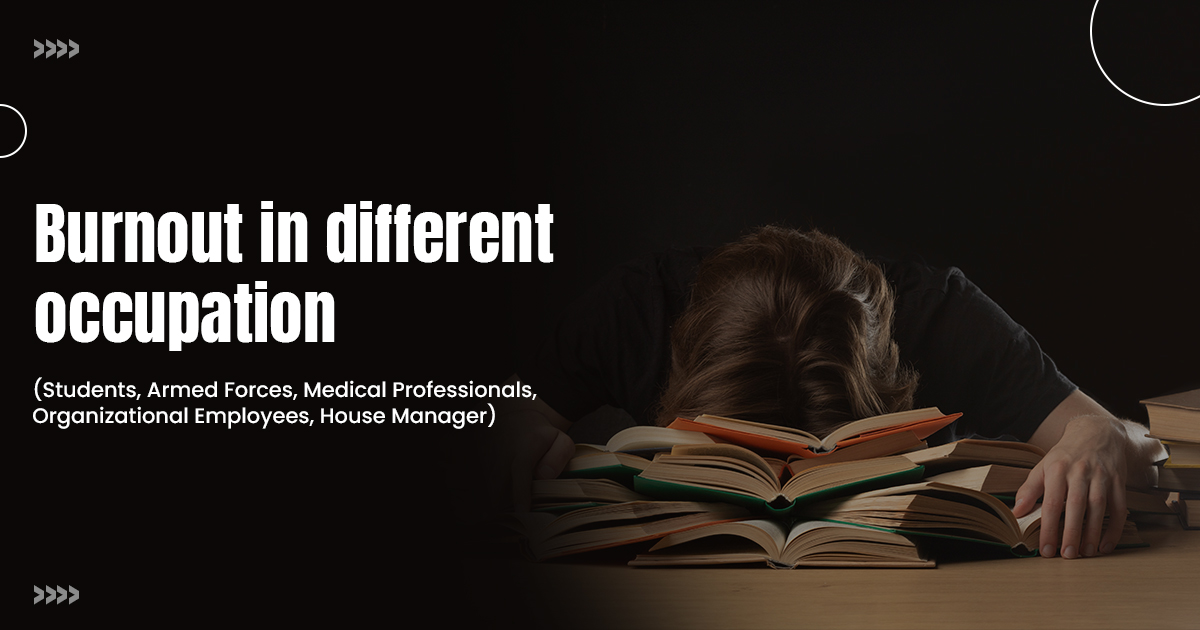
Burnout in different occupations
There are aspects of stress and burnout in every vocation. Three factors can be identified as indicators of occupational burnout:
- Diminished professional efficacy
- Sentiments of negativity or cynicism about one's work
- Feelings of depletion or tiredness
Individuals who work in environments where they have little influence and excessive demands on their time tend to exhibit higher signs of depression. Individuals who encounter inadequate emotional support at work are more likely than others to show signs of depression and burnout. Today, we will discuss burnout in different occupations.
Burnout in students
A state of physical, mental, or emotional fatigue is known as burnout. Students experience burnout when they cannot take breaks and rest and are forced to deal with constant tension or anger. It's a particular kind of burnout brought on by protracted stress from school. Of course, for pupils to succeed, there must be some stress. It may inspire them to make plans and follow through on them.
Student burnout results from spending weeks or months studying the same topic, working on the same project, or attending school nonstop for years.
How to deal with student burnout?
Acknowledge:
If any of the above signs resonate with you, you're on the right track. Remember that the first step in controlling student burnout is acknowledgement. It would help if you noticed any changes in your mental, bodily, and emotional states, regardless of whether you've gotten more irritable or have started sleeping longer. It is simpler to deal with burnout the sooner you recognize it is occurring.Reverse:
When you suspect you could be experiencing student burnout, it's time to repair the harm using constructive coping mechanisms. Here are a few instances of successful coping mechanisms:Seeking help
Depending on your symptoms, you can seek assistance from your parents, a general practitioner, friends, a college counselor, or a mentor.Meditation
It helps you centre and quiet your thoughts, making it perfect for students with excessive tension and anxiety.Breaks
If you can leave college, take advantage of this opportunity to recuperate from student burnout. If not, pause during the day to prevent working too much.Hobbies
Investing time in enjoyable pursuits, such as artistic or physical endeavours, might help you manage student burnout.Armed Forces
There are three main settings in which military pressures arise: garrisons, training activities, and deployments. Significant strain on the body, mind, and emotions can result in issues with psychological health. Depression, anxiety, and posttraumatic stress disorder are a few examples of these.
How can burnout in the armed forces be managed?
- Identify the symptoms of burnout.
- Control your workload and expectations.
- Develop your coping mechanisms and resilience.
- Seek out and provide connection and support.
It was conceptualised as a fatality since it is also known as the disease of the warrior or the illness of the person who initially invests in his profession too intensely and subsequently experiences setbacks. They supported the idea that burnout is uncontrollable because it is linked to personal vulnerability. Organisations can use a variety of interventions to manage this syndrome.
Such interventions can include human resources management through suitable recruitment and selection processes and organisational justice practices, giving employees the support they need, avoiding workload and role ambiguity, and encouraging task variety.
Medical Professionals
Work-family conflict, irrational patient expectations, constant pressure to learn new skills, lengthy workdays, an abundance of bureaucracy, organizational problems, inadequate communication among healthcare personnel, and personal problems are all linked to burnout in the medical field.
- What are some strategies for managing medical professionals' burnout?
- Exercise frequently and partake in other healing pursuits.
- One important strategy for lowering burnout among healthcare professionals is to manage workload.
Burnout harms all facets of life, including relationships, employment, and home life. Long-term physical changes brought on by burnout also increase susceptibility to infections. Due to its numerous repercussions, burnout must be addressed immediately. Our Resiliency Program is here to help you manage burnout more effectively.